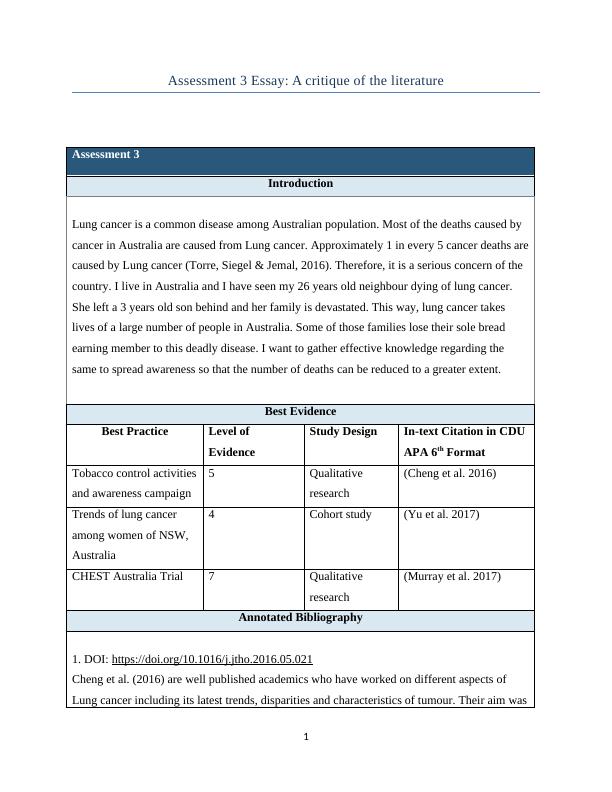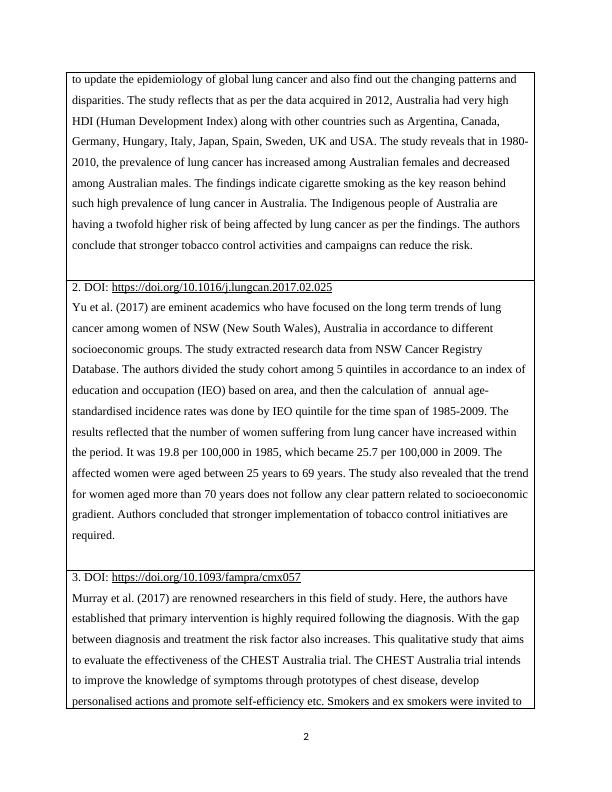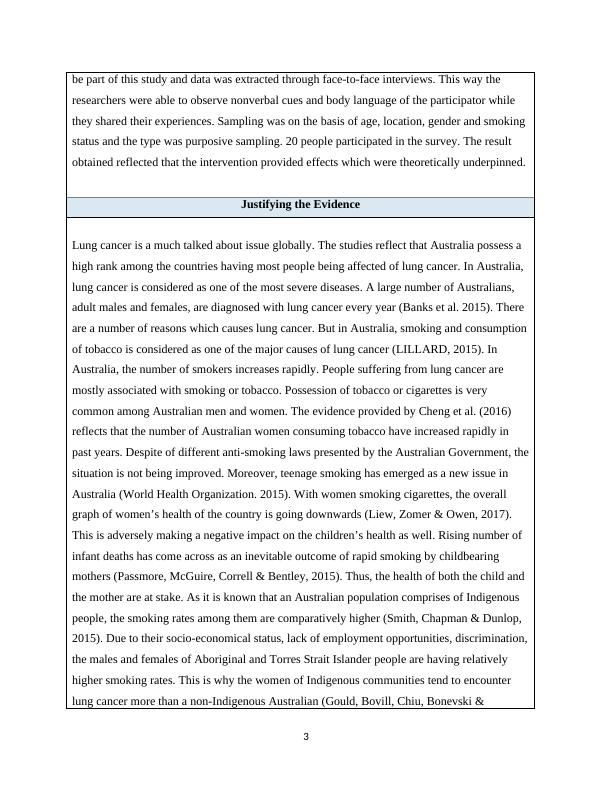A Critique of the Literature on Lung Cancer in Australia
Added on 2023-06-03
8 Pages2602 Words185 Views
Assessment 3 Essay: A critique of the literature
Assessment 3
Introduction
Lung cancer is a common disease among Australian population. Most of the deaths caused by
cancer in Australia are caused from Lung cancer. Approximately 1 in every 5 cancer deaths are
caused by Lung cancer (Torre, Siegel & Jemal, 2016). Therefore, it is a serious concern of the
country. I live in Australia and I have seen my 26 years old neighbour dying of lung cancer.
She left a 3 years old son behind and her family is devastated. This way, lung cancer takes
lives of a large number of people in Australia. Some of those families lose their sole bread
earning member to this deadly disease. I want to gather effective knowledge regarding the
same to spread awareness so that the number of deaths can be reduced to a greater extent.
Best Evidence
Best Practice Level of
Evidence
Study Design In-text Citation in CDU
APA 6th Format
Tobacco control activities
and awareness campaign
5 Qualitative
research
(Cheng et al. 2016)
Trends of lung cancer
among women of NSW,
Australia
4 Cohort study (Yu et al. 2017)
CHEST Australia Trial 7 Qualitative
research
(Murray et al. 2017)
Annotated Bibliography
1. DOI: https://doi.org/10.1016/j.jtho.2016.05.021
Cheng et al. (2016) are well published academics who have worked on different aspects of
Lung cancer including its latest trends, disparities and characteristics of tumour. Their aim was
1
Assessment 3
Introduction
Lung cancer is a common disease among Australian population. Most of the deaths caused by
cancer in Australia are caused from Lung cancer. Approximately 1 in every 5 cancer deaths are
caused by Lung cancer (Torre, Siegel & Jemal, 2016). Therefore, it is a serious concern of the
country. I live in Australia and I have seen my 26 years old neighbour dying of lung cancer.
She left a 3 years old son behind and her family is devastated. This way, lung cancer takes
lives of a large number of people in Australia. Some of those families lose their sole bread
earning member to this deadly disease. I want to gather effective knowledge regarding the
same to spread awareness so that the number of deaths can be reduced to a greater extent.
Best Evidence
Best Practice Level of
Evidence
Study Design In-text Citation in CDU
APA 6th Format
Tobacco control activities
and awareness campaign
5 Qualitative
research
(Cheng et al. 2016)
Trends of lung cancer
among women of NSW,
Australia
4 Cohort study (Yu et al. 2017)
CHEST Australia Trial 7 Qualitative
research
(Murray et al. 2017)
Annotated Bibliography
1. DOI: https://doi.org/10.1016/j.jtho.2016.05.021
Cheng et al. (2016) are well published academics who have worked on different aspects of
Lung cancer including its latest trends, disparities and characteristics of tumour. Their aim was
1

to update the epidemiology of global lung cancer and also find out the changing patterns and
disparities. The study reflects that as per the data acquired in 2012, Australia had very high
HDI (Human Development Index) along with other countries such as Argentina, Canada,
Germany, Hungary, Italy, Japan, Spain, Sweden, UK and USA. The study reveals that in 1980-
2010, the prevalence of lung cancer has increased among Australian females and decreased
among Australian males. The findings indicate cigarette smoking as the key reason behind
such high prevalence of lung cancer in Australia. The Indigenous people of Australia are
having a twofold higher risk of being affected by lung cancer as per the findings. The authors
conclude that stronger tobacco control activities and campaigns can reduce the risk.
2. DOI: https://doi.org/10.1016/j.lungcan.2017.02.025
Yu et al. (2017) are eminent academics who have focused on the long term trends of lung
cancer among women of NSW (New South Wales), Australia in accordance to different
socioeconomic groups. The study extracted research data from NSW Cancer Registry
Database. The authors divided the study cohort among 5 quintiles in accordance to an index of
education and occupation (IEO) based on area, and then the calculation of annual age-
standardised incidence rates was done by IEO quintile for the time span of 1985-2009. The
results reflected that the number of women suffering from lung cancer have increased within
the period. It was 19.8 per 100,000 in 1985, which became 25.7 per 100,000 in 2009. The
affected women were aged between 25 years to 69 years. The study also revealed that the trend
for women aged more than 70 years does not follow any clear pattern related to socioeconomic
gradient. Authors concluded that stronger implementation of tobacco control initiatives are
required.
3. DOI: https://doi.org/10.1093/fampra/cmx057
Murray et al. (2017) are renowned researchers in this field of study. Here, the authors have
established that primary intervention is highly required following the diagnosis. With the gap
between diagnosis and treatment the risk factor also increases. This qualitative study that aims
to evaluate the effectiveness of the CHEST Australia trial. The CHEST Australia trial intends
to improve the knowledge of symptoms through prototypes of chest disease, develop
personalised actions and promote self-efficiency etc. Smokers and ex smokers were invited to
2
disparities. The study reflects that as per the data acquired in 2012, Australia had very high
HDI (Human Development Index) along with other countries such as Argentina, Canada,
Germany, Hungary, Italy, Japan, Spain, Sweden, UK and USA. The study reveals that in 1980-
2010, the prevalence of lung cancer has increased among Australian females and decreased
among Australian males. The findings indicate cigarette smoking as the key reason behind
such high prevalence of lung cancer in Australia. The Indigenous people of Australia are
having a twofold higher risk of being affected by lung cancer as per the findings. The authors
conclude that stronger tobacco control activities and campaigns can reduce the risk.
2. DOI: https://doi.org/10.1016/j.lungcan.2017.02.025
Yu et al. (2017) are eminent academics who have focused on the long term trends of lung
cancer among women of NSW (New South Wales), Australia in accordance to different
socioeconomic groups. The study extracted research data from NSW Cancer Registry
Database. The authors divided the study cohort among 5 quintiles in accordance to an index of
education and occupation (IEO) based on area, and then the calculation of annual age-
standardised incidence rates was done by IEO quintile for the time span of 1985-2009. The
results reflected that the number of women suffering from lung cancer have increased within
the period. It was 19.8 per 100,000 in 1985, which became 25.7 per 100,000 in 2009. The
affected women were aged between 25 years to 69 years. The study also revealed that the trend
for women aged more than 70 years does not follow any clear pattern related to socioeconomic
gradient. Authors concluded that stronger implementation of tobacco control initiatives are
required.
3. DOI: https://doi.org/10.1093/fampra/cmx057
Murray et al. (2017) are renowned researchers in this field of study. Here, the authors have
established that primary intervention is highly required following the diagnosis. With the gap
between diagnosis and treatment the risk factor also increases. This qualitative study that aims
to evaluate the effectiveness of the CHEST Australia trial. The CHEST Australia trial intends
to improve the knowledge of symptoms through prototypes of chest disease, develop
personalised actions and promote self-efficiency etc. Smokers and ex smokers were invited to
2

be part of this study and data was extracted through face-to-face interviews. This way the
researchers were able to observe nonverbal cues and body language of the participator while
they shared their experiences. Sampling was on the basis of age, location, gender and smoking
status and the type was purposive sampling. 20 people participated in the survey. The result
obtained reflected that the intervention provided effects which were theoretically underpinned.
Justifying the Evidence
Lung cancer is a much talked about issue globally. The studies reflect that Australia possess a
high rank among the countries having most people being affected of lung cancer. In Australia,
lung cancer is considered as one of the most severe diseases. A large number of Australians,
adult males and females, are diagnosed with lung cancer every year (Banks et al. 2015). There
are a number of reasons which causes lung cancer. But in Australia, smoking and consumption
of tobacco is considered as one of the major causes of lung cancer (LILLARD, 2015). In
Australia, the number of smokers increases rapidly. People suffering from lung cancer are
mostly associated with smoking or tobacco. Possession of tobacco or cigarettes is very
common among Australian men and women. The evidence provided by Cheng et al. (2016)
reflects that the number of Australian women consuming tobacco have increased rapidly in
past years. Despite of different anti-smoking laws presented by the Australian Government, the
situation is not being improved. Moreover, teenage smoking has emerged as a new issue in
Australia (World Health Organization. 2015). With women smoking cigarettes, the overall
graph of women’s health of the country is going downwards (Liew, Zomer & Owen, 2017).
This is adversely making a negative impact on the children’s health as well. Rising number of
infant deaths has come across as an inevitable outcome of rapid smoking by childbearing
mothers (Passmore, McGuire, Correll & Bentley, 2015). Thus, the health of both the child and
the mother are at stake. As it is known that an Australian population comprises of Indigenous
people, the smoking rates among them are comparatively higher (Smith, Chapman & Dunlop,
2015). Due to their socio-economical status, lack of employment opportunities, discrimination,
the males and females of Aboriginal and Torres Strait Islander people are having relatively
higher smoking rates. This is why the women of Indigenous communities tend to encounter
lung cancer more than a non-Indigenous Australian (Gould, Bovill, Chiu, Bonevski &
3
researchers were able to observe nonverbal cues and body language of the participator while
they shared their experiences. Sampling was on the basis of age, location, gender and smoking
status and the type was purposive sampling. 20 people participated in the survey. The result
obtained reflected that the intervention provided effects which were theoretically underpinned.
Justifying the Evidence
Lung cancer is a much talked about issue globally. The studies reflect that Australia possess a
high rank among the countries having most people being affected of lung cancer. In Australia,
lung cancer is considered as one of the most severe diseases. A large number of Australians,
adult males and females, are diagnosed with lung cancer every year (Banks et al. 2015). There
are a number of reasons which causes lung cancer. But in Australia, smoking and consumption
of tobacco is considered as one of the major causes of lung cancer (LILLARD, 2015). In
Australia, the number of smokers increases rapidly. People suffering from lung cancer are
mostly associated with smoking or tobacco. Possession of tobacco or cigarettes is very
common among Australian men and women. The evidence provided by Cheng et al. (2016)
reflects that the number of Australian women consuming tobacco have increased rapidly in
past years. Despite of different anti-smoking laws presented by the Australian Government, the
situation is not being improved. Moreover, teenage smoking has emerged as a new issue in
Australia (World Health Organization. 2015). With women smoking cigarettes, the overall
graph of women’s health of the country is going downwards (Liew, Zomer & Owen, 2017).
This is adversely making a negative impact on the children’s health as well. Rising number of
infant deaths has come across as an inevitable outcome of rapid smoking by childbearing
mothers (Passmore, McGuire, Correll & Bentley, 2015). Thus, the health of both the child and
the mother are at stake. As it is known that an Australian population comprises of Indigenous
people, the smoking rates among them are comparatively higher (Smith, Chapman & Dunlop,
2015). Due to their socio-economical status, lack of employment opportunities, discrimination,
the males and females of Aboriginal and Torres Strait Islander people are having relatively
higher smoking rates. This is why the women of Indigenous communities tend to encounter
lung cancer more than a non-Indigenous Australian (Gould, Bovill, Chiu, Bonevski &
3

End of preview
Want to access all the pages? Upload your documents or become a member.
Related Documents
LUNG CANCER AMONG INDIGENOUS COMMUNITIES IN ARNHEM LAND Name of the Author Authorlg...
|18
|3993
|109
Introduction to Epidemiology (401076) Assignment 1lg...
|6
|630
|213
Tobacco Health Campaign Against Cancerlg...
|9
|2429
|12
Epidemiology for Practice Assignment Reportlg...
|6
|2014
|18
Nursing Public Health: Bowel Cancer in Australialg...
|13
|3157
|92
Effectiveness of Radiotherapy for Non-Small Cell Lung Cancer: An Evidence-Based Essaylg...
|10
|2675
|389
